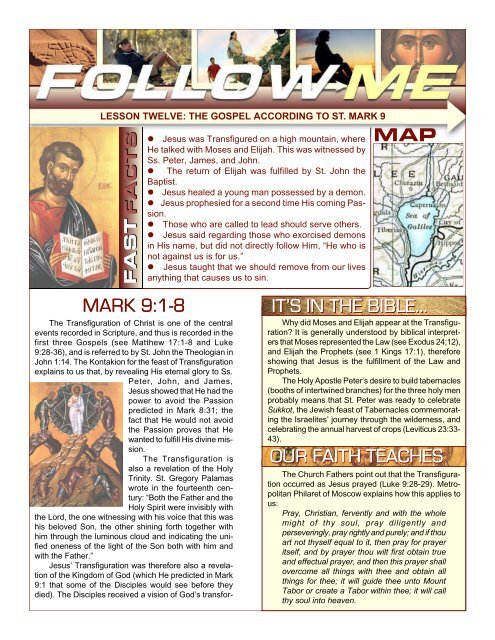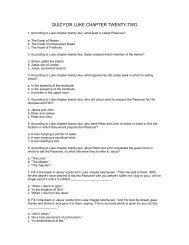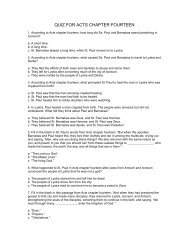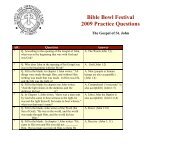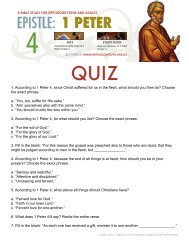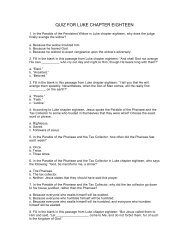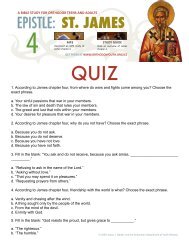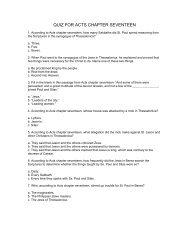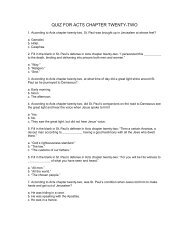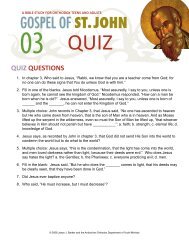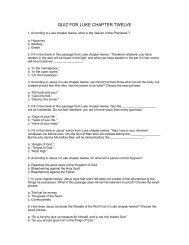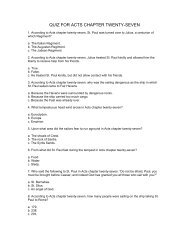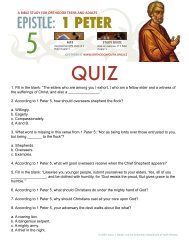Mark 9 - Orthodox Christian Bible Studies
Mark 9 - Orthodox Christian Bible Studies
Mark 9 - Orthodox Christian Bible Studies
You also want an ePaper? Increase the reach of your titles
YUMPU automatically turns print PDFs into web optimized ePapers that Google loves.
LESSON TWELVE: THE GOSPEL ACCORDING TO ST. MARK 9FAST FACTSFAST FACTSMARK 9:1-8The Transfiguration of Christ is one of the centralevents recorded in Scripture, and thus is recorded in thefirst three Gospels (see Matthew 17:1-8 and Luke9:28-36), and is referred to by St. John the Theologian inJohn 1:14. The Kontakion for the feast of Transfigurationexplains to us that, by revealing His eternal glory to Ss.Peter, John, and James,Jesus showed that He had thepower to avoid the Passionpredicted in <strong>Mark</strong> 8:31; thefact that He would not avoidthe Passion proves that Hewanted to fulfill His divine mission.The Transfiguration isalso a revelation of the HolyTrinity. St. Gregory Palamaswrote in the fourteenth century:“Both the Father and theHoly Spirit were invisibly withthe Lord, the one witnessing with his voice that this washis beloved Son, the other shining forth together withhim through the luminous cloud and indicating the unifiedoneness of the light of the Son both with him andwith the Father.”Jesus’ Transfiguration was therefore also a revelationof the Kingdom of God (which He predicted in <strong>Mark</strong>9:1 that some of the Disciples would see before theydied). The Disciples received a vision of God’s transfor-• Jesus was Transfigured on a high mountain, whereHe talked with Moses and Elijah. This was witnessed bySs. Peter, James, and John.• The return of Elijah was fulfilled by St. John theBaptist.• Jesus healed a young man possessed by a demon.• Jesus prophesied for a second time His coming Passion.• Those who are called to lead should serve others.• Jesus said regarding those who exorcised demonsin His name, but did not directly follow Him, “He who isnot against us is for us.”• Jesus taught that we should remove from our livesanything that causes us to sin.MAPIT’S IN THE BIBLE...Why did Moses and Elijah appear at the Transfiguration?It is generally understood by biblical interpretersthat Moses represented the Law (see Exodus 24;12),and Elijah the Prophets (see 1 Kings 17:1), thereforeshowing that Jesus is the fulfillment of the Law andProphets.The Holy Apostle Peter’s desire to build tabernacles(booths of intertwined branches) for the three holy menprobably means that St. Peter was ready to celebrateSukkot, the Jewish feast of Tabernacles commemoratingthe Israelites’ journey through the wilderness, andcelebrating the annual harvest of crops (Leviticus 23:33-43).OUR FAITH TEACHESThe Church Fathers point out that the Transfigurationoccurred as Jesus prayed (Luke 9:28-29). MetropolitanPhilaret of Moscow explains how this applies tous:Pray, <strong>Christian</strong>, fervently and with the wholemight of thy soul, pray diligently andperseveringly, pray rightly and purely; and if thouart not thyself equal to it, then pray for prayeritself, and by prayer thou wilt first obtain trueand effectual prayer, and then this prayer shallovercome all things with thee and obtain allthings for thee; it will guide thee unto MountTabor or create a Tabor within thee; it will callthy soul into heaven.
mation of all creation. Archbishop Dmitri Royster explains:“In the dazzling light, in which the very mountain and allthe surroundings were altered, there is a glimpse of thetransfigured world (cosmos), when God will be all in all,when the Kingdom is finally established.”MARK 9:14-32Jesus again confronted a lack of faith among Hisfollowers. His Disciples were unable to exorcise a demonfrom a young man, and even the boy’s father —who brought his son to Jesus — doubted whether Jesushad the ability to exorcise the demon. Jesus lamentstheir faithlessness (vs. 19), comments that all things arepossible to those who believe (vs. 23), and yet againexperienced faithlessness in His Disciples when they stillrefused to accept that Jesus would die and rise again. Allof these things point to the need to cry out with the fatherof the demonized boy, “Lord, I believe; help my unbelief”(vs. 24)!MARK 9:33-50The <strong>Orthodox</strong> Study <strong>Bible</strong> titles the last third of thischapter “The Way of Discipleship” because in it Jesusdescribed some of the attributes needed in a wholeheartedfollower of Christ.Jesus first taught the Disciples that they must avoidpride and greed in their lives. Rather than fulfilling theircalling as disciples so that they couldreceive status and recognition fortheir accomplishments, <strong>Christian</strong>sshould be like youngchildren: innocent and unconcernedwith things likestatus (vv. 33-37, 42). TheShepherd of Hermas explains:“Thy are as veritableinfants, whose heartsdo not invent evil, whohardly know what corruptionis, and who haveremained childlikeforever. People suchas these, therefore,undoubtedly dwell inthe kingdom of God,OUR FAITH TEACHESDo <strong>Orthodox</strong> <strong>Christian</strong>s believe that people willforever be tormented in literal, physical fire and brimstone?There are certainly some <strong>Christian</strong>s who believethat those who reject God will spend eternity burningin a fiery hell. Traditionally, however, the <strong>Orthodox</strong>Church teaches a different understanding of the fireand torment.St. John of Damascus writes, “Sinners will be givenover to everlasting fire, which will not be a material firesuch as we are accustomed to, but a fire such as Godmight know.” St. John’s teaching can be better understoodby looking at two biblical references to fire andlight in relation to God. Holy Scripture describes God’spresence as a “consuming fire” (Hebrews 12:29) andan “unapproachable light” (1 Timothy 6:16) that delightsthose who love Him, but causes anguish and pain inthose who do not “love His appearing” (2 Timothy 4:8).Therefore, for those who love God, resurrection fromthe dead and the presence of God will be paradise. Forthose who hate God, however, resurrection from thedead and the presence of God will be hell.because they in no way defile God’s commandments.”Jesus next confronted the danger of sectarianism (asect is a group that separates itself from all others, oftenviewing itself as good and all others as evil) when HisDisciples were concerned that individuals who were notdirectly following Jesus were nonetheless able to exorcisedemons in His name (which, ironically, the Disciplesthemselves had just been unable to do). Jesus simplyresponded, “He who is not against us in on our side” (vs.42).Jesus went on to explain that <strong>Christian</strong>s should leaveand avoid anything that tempts us to sin (vv. 43-48). Hedid not mean to literally dismember ourselves: instead,he used such shocking imagery to reinforce how thoroughlywe should refuse to let anything come betweenGod and us. He already said that <strong>Christian</strong>s should notvalue their lives more than Him (see 8:35-36); later inthis Gospel He will similarly warn that we should not loveour possessions (10:21), or even our family (10:28), morethan we love God.WHAT DID I LEARN ABOUT FOLLOWING JESUS?• St. Luke adds a detail regarding Jesus’ activity when the Transfigurationoccurred. Do I follow His example?• Do I pray the same thing as the father in verse 24: “Lord, Ibelieve; help my unbelief?” What do I believe, and where do I need to grow?• Am I concerned with status and power, or is my relationship with God likethe children He praised in vv. 33-37?• Are there things in my life that I need to “amputate” to draw closer to God?


